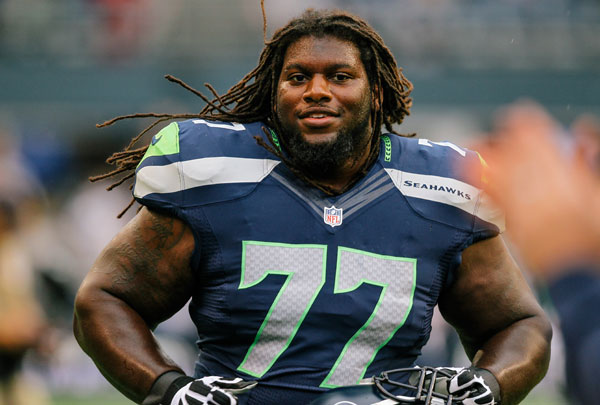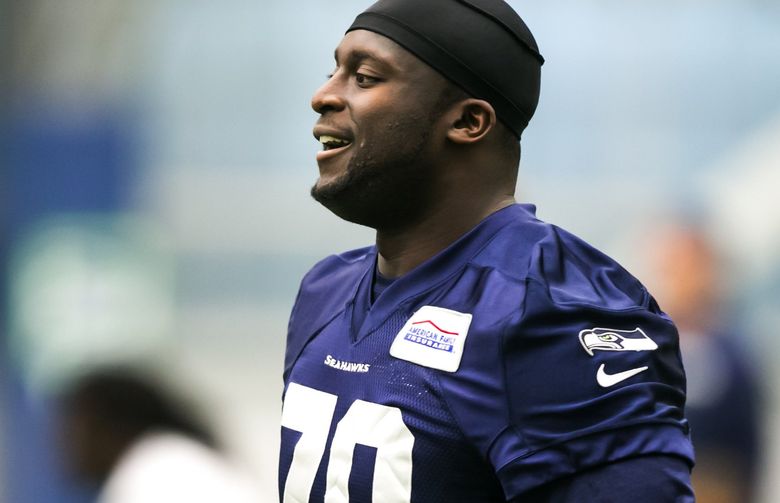
James Carpenter earns nearly $5m a year with the Jets
When people discuss Seattle’s approach to the O-line, the following points usually come up:
— They’ve not spent enough on the O-line
— They’ve prioritised other positions
— They could’ve/should’ve done more
I want to offer a counter to those thoughts today.
Since 2010, the Seahawks have used 19 draft picks between rounds 1-3. Here’s a breakdown of what they’ve spent those picks on:
O-line: 6
D-line: 3
Wide receiver: 3
Linebacker: 2
Running back: 2
Safety: 1
Quarterback: 1
32% of Carroll’s/Schneider’s picks in the first three rounds have been spent on the offensive line. That’s double the amount of defensive linemen and receivers — ranked second on the list.
It has been argued that the Seahawks have either misused these picks (bad evaluations) or have chosen not to re-sign the players they drafted to save money (priorities).
Context is required.
For example, the Dallas Cowboys are praised for drafting Tyron Smith, Travis Frederick and Zack Martin with back-to-back-to-back first round picks. The Seahawks, when they have sought to address these positions, have not been in position to draft players of similar quality.
Had they lost to St. Louis in week 17 of the 2010 regular season, the Seahawks wouldn’t have made the playoffs (no Beastquake) and would’ve picked #8 overall in the 2011 draft. There is every chance they would’ve used that pick to draft Tyron Smith, who was taken by Dallas at #9. Instead the Seahawks picked at #25.
By that point Smith, Mike Pouncey, Nate Solder, Anthony Castonzo and Danny Watkins had all been drafted. Determined to address a need on the O-line, the Seahawks selected James Carpenter.
Aside from a couple of injury hit seasons, the Seahawks got a good few years out of Carpenter. That’s more than can be said for Watkins who was taken at #23 (barely played and became a firefighter) and the next two offensive linemen drafted after Carpenter (two enormous busts, Gabe Carimi and Derek Sherrod).
When Carpenter left the Seahawks he signed a four year, $19m contract with the Jets worth nearly $5m a year. Carpenter was decent for the Seahawks — but would you really want to keep him at $5m a year?
That wasn’t the Seahawks being cheap — either in terms of draft investment or ponying up the free agent cash. They prioritised the O-line with the high draft pick. They took the best remaining option on the board. They got a few years out of him and then the player signed a big deal somewhere else.
Had they been able to draft Pouncey or Solder or Smith — it probably would’ve been a different discussion. They might’ve been worth $7-12m a year or whatever it would’ve taken to get the deal done. Is Carpenter worth $5m a year to this Seahawks team? At a time when they’ve had to pay Russell Wilson, Richard Sherman, Earl Thomas and a host of others top-tier money?
Now onto Okung. This was Seattle’s first draft pick by Carroll/Schneider. They immediately made a left tackle their priority and used the #6 overall pick to get one. Under the old CBA, they also gave Okung a contract worth $48m with $29m in guarantees.
We’re all familiar with his injury record since 2010 but here’s a reminder:
2010 — missed six games
2011 — missed four games
2012 — missed one game
2013 — missed eight games
2014 — missed two games
2015 — missed three games
That’s 24 missed games during his six-year rookie contract. When he missed those eight games in 2013 (the Super Bowl season) the Seahawks were forced to start Paul McQuistan at left tackle for half of the regular season.
Okung was good when he played — but not great. He never achieved the level of Trent Williams (taken two picks earlier in the 2010 draft) and was more serviceable than dominant.
Right now a lot of fans (and probably some of the staff) would settle for that over the current starting left tackle. Yet a front office has to consider many different factors when considering a contract extension. Okung, without question, was an injury liability. If you offer him the big bucks and he continues to miss four, six or eight games a year — do you regret it?
If he was still on Seattle’s roster now albeit injured, would people be criticising the front office for re-signing him?
Then there’s the angle of his decision not to use an agent. The deal he signed in Denver was widely mocked for being the ultimate team friendly contract. Was such a contract ever a possibility in Seattle? Or did Okung need to move on in the face of growing criticism for not using an experienced negotiator?
We’ll never know the exact details — but this was clearly a complex situation. Not exclusively a cost saving measure.
The Seahawks got a good few years from both Okung and Carpenter. Neither was a terrible pick or a bad evaluation. Both moved on. The success or failure of a first round pick should not be focused exclusively on whether they get a second contract. Was the Bruce Irvin pick a failure? Arguably all three players played their part — but ultimately others (UDFA WR’s, 5th round cornerbacks, third round QB’s, free agent DE’s) contributed more.
They also let Breno Giacomini (signed for the Jets for $4.5m a year) and J.R. Sweezy (signed with the Buccs for $6.5m a year) walk.
Again, would you really want to keep those two players at that price? Sweezy’s average annual salary in Tampa Bay is only $650,000 less than Michael Bennett’s and Cliff Avril’s (they both earn an average of $7.125m a year in Seattle).
As a consequence the investment in the O-line has continued via the draft. In a weak year (2014) for explosive offensive linemen, they spent a second round pick on the best player remaining that fit their criteria (explained in detail here). It’s taken Justin Britt a while to work it out — but he looks at home at center.
This year they spent another first round pick on the O-line drafting the hulking, explosive, enormous athlete Germain Ifedi. In pre-season he looked terrific and the hope is he’ll get healthy and become a major asset for the offense. They also spent a third rounder on Rees Odhiambo. He’s yet to feature — but once again they’re making the investment.
Many have questioned the decision to trade Max Unger for Jimmy Graham and his $9m a year salary. Graham had a rough start to his Seahawks career with minimal production and a serious knee injury. Unger played 16 games and earned a new contract with the Saints.
Was it a mistake? Maybe. But again context is required. Unger missed thirteen games in 2013/2014 for the Seahawks. Perhaps the less aggressive, pass-friendly offense suits him physically in New Orleans? And while it hasn’t worked out for Graham in Seattle so far — he remains one of the most unique players in the league and could still become a major asset.
Unger’s new deal is worth $7.4m a year on average. That’s more money than Avril and Bennett. While it’s true the Seahawks spend less on their O-line than anyone else ($8.597m this year) — can you justify a $7.4m cap hit for a center in his 31st year who missed 13 games in his last two seasons for you?
Since moving Unger there really hasn’t been an opportunity to draft a center of the quality of, for example, Travis Frederick. In the 2015 draft, Mitch Morse (#49) and Ali Marpet (#61) were both taken before Seattle’s pick at #63. If the Seahawks had any interest in Ryan Kelly this year, he was long gone by their pick at #26.
It’s possible they fully intended to draft a young center but it just wasn’t possible. Again, that’s just the way the draft works sometimes. You can’t fight the board. Consequently the Seahawks appear to have found a viable solution (possibly for the long term) in Britt.
Not helping the situation has been Seattle’s draft position. They owned pick #6 and #14 in 2010 and #12 in 2012. Aside from that they’ve consistently had picks in the late first round (and picks at the end of each subsequent round). They simply haven’t been in position to draft a Pouncey or a Martin in the middle of the first round.
With a growing demand for athletic, talented O-liners — not many are lasting into the late first. Ifedi is/was a rarity. There’s a chance the league will regret letting him last that long. Players with his length, athleticism, aggression and size don’t come around very often. Quite a few teams will regret allowing Kelechi Osemele to last into round two — Ifedi has a similar physical skill set.
Aside from Ifedi, you could argue Seattle’s success has ultimately prevented them getting at the top O-liners since 2012. What can they really do about that?
Ask yourself this question — which highly touted O-liner have they passed on? Who did they snub in favour of another position? There isn’t anyone. (EDIT: Attyla the Hawk noted they passed on Joel Bitonio for Paul Richardson in 2014. Point taken)
Here’s what it comes down to: They’ve used a lot of high draft picks on the O-line but the players available and their overall value to the team haven’t matched the contracts they’ve received from other clubs when becoming free agents.
That’s not being cheap. That’s not deliberately being thrifty on the O-line. That’s not ignoring the position. Had they been able to draft a Tyron Smith or Zack Martin they probably would’ve done — and they probably would’ve extended their contracts.
You can only draft the players available. You can’t magic up elite linemen. You can’t magic up top-16 picks either. If they get a great O-liner they’ll probably reward them as they’ve done with the Baldwin’s, Avril’s and Bennett’s etc.
Most of their decisions have been forced. Players getting good deals elsewhere, players being injured, other players at other positions playing really well and eating up cap space.
I don’t think they’re trying to manage this situation because they’ve decided to spend less on the O-line — I think they’re managing this situation because they have to. These are the cards they’ve been dealt.
Check out this weeks podcast, where we discuss the latest college football, draft and Seahawks topics:



